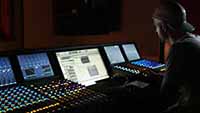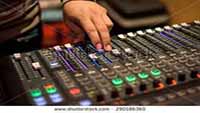 There are some simple and useful methods during the process of music mixing, which will help you improve the sound composition significantly. Of course, the final word is always with a musician himself and a sound producer, but some helping from the technology’s world will do no harm exactly.
There are some simple and useful methods during the process of music mixing, which will help you improve the sound composition significantly. Of course, the final word is always with a musician himself and a sound producer, but some helping from the technology’s world will do no harm exactly.
The Spectrum Analysis
A bass drum (kick) and bass line are a fundamental part of any track in the most styles of electronic dance music. The problem is that the drum and bass are located in the close frequency bands. The result is that their frequencies will begin to clash with each other eventually that will lead to the problems both at a step of mixing and song’s mastering.
In fact, this situation is true practically for all styles of music, not only electronic’, so that we will ask rock and metal’s fans to stay with us et seq. We all know about the popular reception of rap vocal mixing with the cutting out of frequencies in the sub lows’ vicinity and EQ bass so that it makes "flowed around" sound of the bass drum. The problem of the popular and undoubtedly effective reception implies that short-duration failure will be difficult to hear without using of high-quality near-field monitors. So what do you do in this situation? Take refuge in a spectrum analyzer.
We say at once that the spectrum analyzer is not exactly a panacea and universal solution, but using it will help to "see" what our ears cannot hear.
 Within the boundlessness of music forums and various music discussions regarding music mixing, it can be found millions of messages relating to the address problems of bass redundancy. The problem is that 95 percent of solutions offered to change (improve) the acoustic environment of an electronic dance music mixing and mastering, rearrange or even change the studio monitors and / or headphones at all, resort to a remedy of expensive cables, almost a golden winding, or engage mixing under the full moon. Joke. In general, talk is but talk, but the usage of such advice is very few, especially for a beginner, and can disorient him completely.
Within the boundlessness of music forums and various music discussions regarding music mixing, it can be found millions of messages relating to the address problems of bass redundancy. The problem is that 95 percent of solutions offered to change (improve) the acoustic environment of an electronic dance music mixing and mastering, rearrange or even change the studio monitors and / or headphones at all, resort to a remedy of expensive cables, almost a golden winding, or engage mixing under the full moon. Joke. In general, talk is but talk, but the usage of such advice is very few, especially for a beginner, and can disorient him completely.
So how in the world to fight with the sound mud emerging from a bass overabundance? The answer is rather simple: we need a parametric EQ. Little will be saying about the free of charge plugins, as any full-function workstation includes an equalizer of this kind. Initially all we need ─ to resort to the low-pass filtering.
How to Use
Add a parametric EQ on the Master Bus in the DAW main window. Set an Low Pass filter at the 100Hz mark to cut off all frequencies outside 100Hz. Be sure to turn on the monitoring in order to see clearly what frequencies are hearing in this track.
Rectify the equalizer as described above, turn on the reproduction of your own musical masterpiece and oversee what frequencies are in front of the 100Hz mark. Espied the presence of such frequencies, you need to turn off alternately the project’s tracks one by one to identify the "causer".
Hence, it is tempting to infer that there is, of course, the bass and drums’ frequencies are appearing here. All is well, and their frequencies are here to stay exactly, which is true for mixing Hip-Hop and Rock either - any of genre actually.. Our task is to catch the other musical instruments creating musical mud inside the mix in this sphere.
 Even if the monitors / headphones in your affordable mixing and mastering services are far from required quality, this method will work. The 100Hz mark – it is a point where there should be nothing superfluous.
Even if the monitors / headphones in your affordable mixing and mastering services are far from required quality, this method will work. The 100Hz mark – it is a point where there should be nothing superfluous.
It is necessary to begin the process of cleaning the mix after identifying redundant instruments in this frequency band. Cut the lower frequency at all the instruments by the equalizer, which fits into the 100Hz vicinity, until you are satisfied with the result. Ultimately, freeing this vicinity from the other instruments’ musical mud, we will give more space to the bass drum. Moreover, this, in turn, will avoid the problems mentioned during reviewing the spectral analyzer.
NOTE: Although all that was written above, having a small bleeding of other instruments into the 100Hz vicinity ─ not always terrible, mortally and ultimate. First, believe your own ears, personal experience and only then to all other technical instruments. + Bleeding is beneficial sometimes to the sound in the upper lows of sounding, so it is not necessary to clean everything without remainder with the maniac’s tenacity that is in the 100Hz vicinity. Sterility is not the best option as well.
It is causing greater attention to be paid to density and pulsation of the rhythm-section in the music style of techno ─ bass and drum must "swing" all and sundry, set a tight rhythm and almost "flabbergast" a listener. Most producers and sound designers, who engaged in modern music mixing, prefer to build the process of composition’s mixing around the bass drum: all other track’s elements are panned and located on the volume level with caution on the drum.
